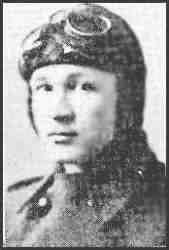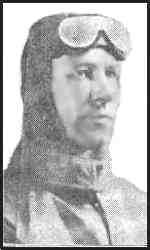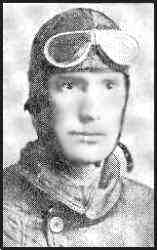

Veteran British Royal Flying Corps.
|
OREGON-WASHINGTON-IDAHO AIRPLANE CO., 1920 These are the Four Pilots of the New Company |

| 
| ||
Veteran British Royal Flying Corps. |
|||
| Walter E. Lees of the quartet of airmen recruited by the company for northwestern service, flew for five years in the employment of the Curtiss company. During the war he was a lieutenant-inspector of government aircraft. Upon his return to the Curtiss company, he was in charge of the Curtiss pleasure squadron at Atlantic City, where several Portland people were among the many thousands who made an aerial debut with him. | Captain F. S. McClurg, another of the four fliers in the local service, is an "ace of aces." To his official credit the British military authorities -- for he flew and fought under the insignia of the Royal Flying corps -- place 17 enemy aircraft. Unofficially, his record of broken and defeated Huns, bested at duello in mid-air, is 25 machines. Captain McClurg, an American, sailed overseas with the first Canadian troops. In the Verdun sector, his regiment went into battle and came back with but 30 men and four officers. It was then that McClurg, a private, chose the cloud sector as his own, and was transferred to the Royal Flying corps. He has been decorated by both the French and British governments. King Albert of Belgium was thrice his passenger on trips over the Belgian front -- and his name is one to conjure with among the allied and enemy airmen who escaped the perils of their deadly work in war. |

| 
| ||
| Victor Vernon, pilot, has flown since 1913, when he owned and operated a hydroplane, making passenger flights from New York to Florida. In 1915, he was called by the Curtiss people as test pilot, and in 1916, was inducted into government service as civilian instructor to the first fledglings of America's air fleets. Later, he trained many of the first Canadian fliers who went overseas to contest cloud supremacy with the Hun. In 1918, he entered the American naval air service as a test pilot, and flew the big "Hydros," the N-C covey, that sped the first trail across the winds of the Atlantic. Before he returned to the Curtiss company, he was in conference at Washington relative to the first aerial mail service routes blazed by the government. | J. D. Hill, fourth of the pilots, entered aviation with Glenn Curtiss in 1912, and was one of his first
pilots. He has flown continuously ever since, with the record of never having damaged a plane or injured a passenger. In 1916, he
was appointed civilian instructor by the government, and was in charge of the St. Charles school and Scott field. He has flown in every
known variety of plane, not only American, but all foreign makes. At one time, he was the holder of the air record between Buffalo
and New York, a distance of 440 miles, made in 3 hours and 20 minutes. It is Hill whose airy ramblings total seven times the girth of the
globe.
1928? September 6. James D. Hill was lost at sea during an attempt to cross the Atlantic from Old Orchard, Maine to Rome. The flight had been drummed up as a promotion stunt for William Randolph Hearst's New York Daily Mirror. The plane was a one-engined Fokker, the Old Glory. The pilot, Lloyd Bertaud, had brought Hill along to act as navigator, he having been a fellow airmail pilot |
 |
 |
||
| |
|
|
The present flight equipment consists of two flying boats, the renowned Curtiss Sea Gulls --- 150 h. p. and 85 miles per with passengers --- and three land planes, the Curtiss J-N type. Ten additional planes are now en route from the east, and two of these will be the deluxe editions of the last word in aviation. They are of the Curtiss flock, the |